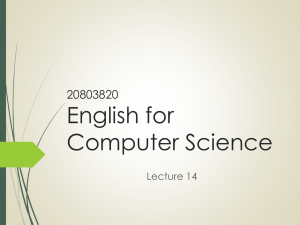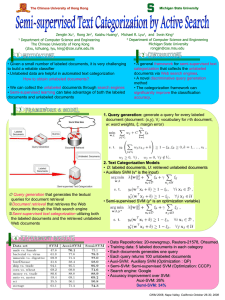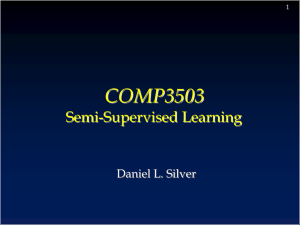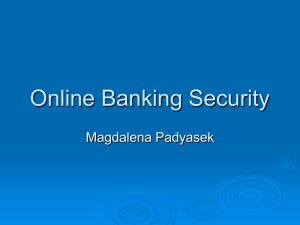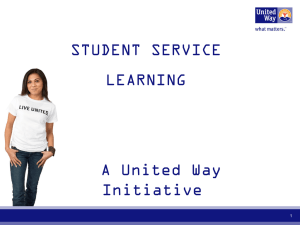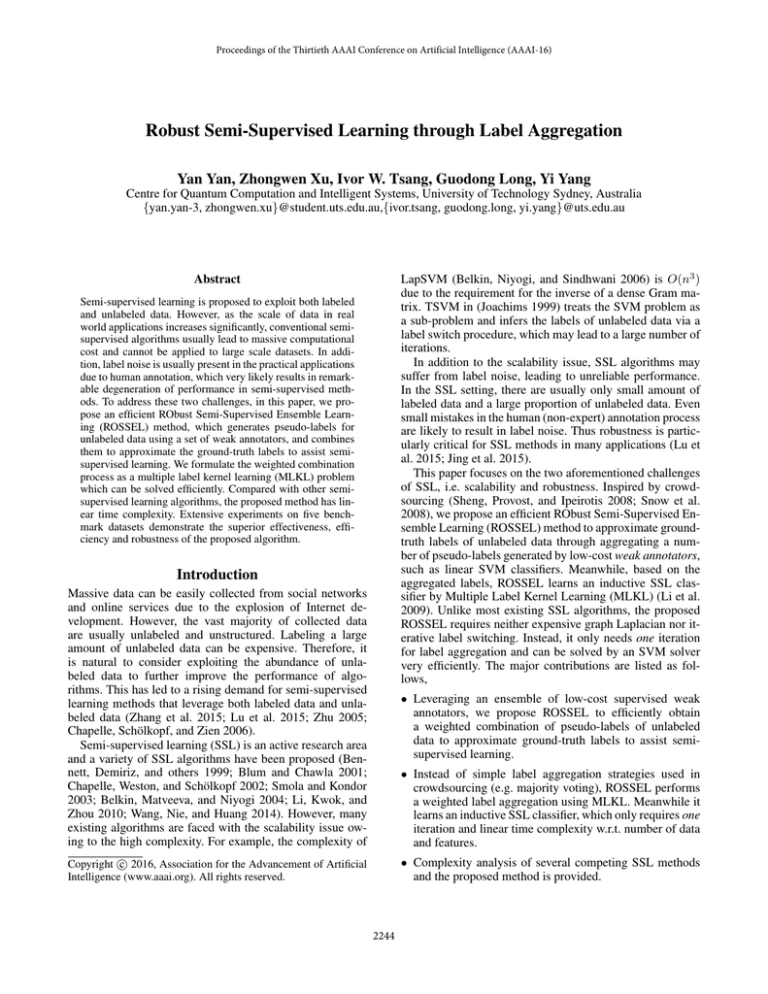
Proceedings of the Thirtieth AAAI Conference on Artificial Intelligence (AAAI-16)
Robust Semi-Supervised Learning through Label Aggregation
Yan Yan, Zhongwen Xu, Ivor W. Tsang, Guodong Long, Yi Yang
Centre for Quantum Computation and Intelligent Systems, University of Technology Sydney, Australia
{yan.yan-3, zhongwen.xu}@student.uts.edu.au,{ivor.tsang, guodong.long, yi.yang}@uts.edu.au
LapSVM (Belkin, Niyogi, and Sindhwani 2006) is O(n3 )
due to the requirement for the inverse of a dense Gram matrix. TSVM in (Joachims 1999) treats the SVM problem as
a sub-problem and infers the labels of unlabeled data via a
label switch procedure, which may lead to a large number of
iterations.
In addition to the scalability issue, SSL algorithms may
suffer from label noise, leading to unreliable performance.
In the SSL setting, there are usually only small amount of
labeled data and a large proportion of unlabeled data. Even
small mistakes in the human (non-expert) annotation process
are likely to result in label noise. Thus robustness is particularly critical for SSL methods in many applications (Lu et
al. 2015; Jing et al. 2015).
This paper focuses on the two aforementioned challenges
of SSL, i.e. scalability and robustness. Inspired by crowdsourcing (Sheng, Provost, and Ipeirotis 2008; Snow et al.
2008), we propose an efficient RObust Semi-Supervised Ensemble Learning (ROSSEL) method to approximate groundtruth labels of unlabeled data through aggregating a number of pseudo-labels generated by low-cost weak annotators,
such as linear SVM classifiers. Meanwhile, based on the
aggregated labels, ROSSEL learns an inductive SSL classifier by Multiple Label Kernel Learning (MLKL) (Li et al.
2009). Unlike most existing SSL algorithms, the proposed
ROSSEL requires neither expensive graph Laplacian nor iterative label switching. Instead, it only needs one iteration
for label aggregation and can be solved by an SVM solver
very efficiently. The major contributions are listed as follows,
Abstract
Semi-supervised learning is proposed to exploit both labeled
and unlabeled data. However, as the scale of data in real
world applications increases significantly, conventional semisupervised algorithms usually lead to massive computational
cost and cannot be applied to large scale datasets. In addition, label noise is usually present in the practical applications
due to human annotation, which very likely results in remarkable degeneration of performance in semi-supervised methods. To address these two challenges, in this paper, we propose an efficient RObust Semi-Supervised Ensemble Learning (ROSSEL) method, which generates pseudo-labels for
unlabeled data using a set of weak annotators, and combines
them to approximate the ground-truth labels to assist semisupervised learning. We formulate the weighted combination
process as a multiple label kernel learning (MLKL) problem
which can be solved efficiently. Compared with other semisupervised learning algorithms, the proposed method has linear time complexity. Extensive experiments on five benchmark datasets demonstrate the superior effectiveness, efficiency and robustness of the proposed algorithm.
Introduction
Massive data can be easily collected from social networks
and online services due to the explosion of Internet development. However, the vast majority of collected data
are usually unlabeled and unstructured. Labeling a large
amount of unlabeled data can be expensive. Therefore, it
is natural to consider exploiting the abundance of unlabeled data to further improve the performance of algorithms. This has led to a rising demand for semi-supervised
learning methods that leverage both labeled data and unlabeled data (Zhang et al. 2015; Lu et al. 2015; Zhu 2005;
Chapelle, Schölkopf, and Zien 2006).
Semi-supervised learning (SSL) is an active research area
and a variety of SSL algorithms have been proposed (Bennett, Demiriz, and others 1999; Blum and Chawla 2001;
Chapelle, Weston, and Schölkopf 2002; Smola and Kondor
2003; Belkin, Matveeva, and Niyogi 2004; Li, Kwok, and
Zhou 2010; Wang, Nie, and Huang 2014). However, many
existing algorithms are faced with the scalability issue owing to the high complexity. For example, the complexity of
• Leveraging an ensemble of low-cost supervised weak
annotators, we propose ROSSEL to efficiently obtain
a weighted combination of pseudo-labels of unlabeled
data to approximate ground-truth labels to assist semisupervised learning.
• Instead of simple label aggregation strategies used in
crowdsourcing (e.g. majority voting), ROSSEL performs
a weighted label aggregation using MLKL. Meanwhile it
learns an inductive SSL classifier, which only requires one
iteration and linear time complexity w.r.t. number of data
and features.
• Complexity analysis of several competing SSL methods
and the proposed method is provided.
c 2016, Association for the Advancement of Artificial
Copyright Intelligence (www.aaai.org). All rights reserved.
2244
Related Work
labeled and unlabeled data. Our proposed method consists
of the two steps, namely label generation and label aggregation, illustrated in Figure 1. In the first stage, a set of weak
annotators are trained and applied to unlabeled data to generate a set of pseudo-labels. In the second stage we combine the pseudo-labels to approximate the optimal labels of
unlabeled data. In the meantime, weight vectors is derived,
which enables ROSSEL to handle unseen data.
As large scale data are easily accessible, it is usually difficult
to obtain sufficient supervision in practice. For instance, a
feature selection algorithm is proposed in (Han et al. 2015)
for video recognition where the number of labeled videos are
limited. In (Gan et al. 2015), an action recognition method
is proposed which does not exploit any positive examplars.
The authors in (Li et al. 2013) propose a method to deal
with weak-label learning tasks. In this paper, we focus on
SSL problems.
Among SSL algorithms, graph-based methods are commonly used (Chapelle, Schölkopf, and Zien 2006). Many
graph-based algorithms introduce the manifold structure by
leveraging manifold regularization (Zhu, Ghahramani, and
Lafferty 2003; Zhou et al. 2004; Belkin, Niyogi, and Sindhwani 2005; Sindhwani et al. 2005; Belkin, Niyogi, and
Sindhwani 2006; Tsang and Kwok 2006; Sindhwani, Chu,
and Keerthi 2007; Xu et al. 2010; Zhang et al. 2015). However, the complexity of building graph Laplacian is at least
O(n2 ). Consequently, these graph-based algorithms are usually difficult to handle large scale datasets. Recently, the authors in (Wang, Nie, and Huang 2014) propose an adaptive SSL to optimize the weight matrix of the model and
the label matrix simultaneously, which avoids expensive
graph construction. There are some SSL methods exploiting
pseudo-labels of unlabeled data. For instance, in (Lee 2013),
pseudo-labels are used to make deep neural networks able to
handle unlabeled data. The authors in (Bachman, Alsharif,
and Precup 2014) propose to exploit pseudo-ensembles to
produce models that are robust to perturbation. In (Deng et
al. 2013), pseudo-labels are exploited in an image reranking framework regularized by multiple graphs. The authors
in (Chang et al. 2014) formulate multi-label semi-supervised
feature selection as a convex problem and propose an efficient optimization algorithm. A semi-supervised ranking
and relevance feedback framework is proposed for multimedia retrieval in (Yang et al. 2012). In (Li, Kwok, and Zhou
2009), the authors propose a SVM-based SSL algorithm by
exploiting the label mean. A cost-sensitive semi-supervised
SVM is proposed in (Li, Kwok, and Zhou 2010). Although
these methods avoid expensive graph Laplacian, they still
require a number of iterations for training.
Ensemble learning is a supervised learning paradigm that
trains a variety of learners on a given the training set, and derives a prediction from the votes of all its learners (Dietterich
2000). There are a number of most commonly used ensemble algorithms, including bagging (Breiman 1996), random
forests (Breiman 2001) and boosting (Schapire and Freund
2012). Bagging is one of the most commonly used ensemble algorithms, where a number of bootstrap replicates are
generated on the training set by bootstrap sampling, and
a learner is trained on each bootstrap replicate. Ensemble
learning methods can only handle labeled data.
Label Generation
Low-cost, less-than-expert labels are easy to obtain from
weak annotators in crowdsourcing (Sheng, Provost, and
Ipeirotis 2008). Following the crowdsourcing framework,
ROSSEL firstly generates a set of pseudo-labels for unlabeled data using ensemble learning. In this paper we focus
on bagging to generate pseudo-labels.
Bagging is a simple and effective supervised ensemble learning algorithm, which produces a number of bootstrap replicates using bootstrap sampling. A weak learner is
trained on each bootstrap replicate. By applying these weak
learners on unlabeled data, a set of pseudo-labels can be derived. Bagging finally aggregates all the pseudo-labels by
majority voting to generate predictions.
ROSSEL trains weak annotators using bootstrap sampling. Similar to crowdsourcing, we apply weak annotators
on unlabeled data and obtain the resultant less-than-expert
labels. The label generation procedure is illustrated in Figure 1.
bootstrap
sampling
label generation
replicate
3
replicate
replicate
1 2
labeled
data
weak annotator 3
weak annotator 2
weak annotator 1
unlabeled
data
pseudo-label
3
pseudo-label
pseudo-label
1 2
MLKL
label aggregation
Figure 1: Illustration of the proposed ROSSEL.
Label Aggregation by MLKL
The Proposed Model
Considering a binary supervised learning scenario, let DL =
{xi , yi }li=1 denotes the labeled set, where xi ∈ Rd and
yi ∈ {−1, +1} denotes the feature vector and the label of
the i-th sample, respectively. A general objective function is
formulated as follows
(1)
min Ω(w) + C(w),
Inspired by crowdsourcing methods (Sheng, Provost, and
Ipeirotis 2008; Snow et al. 2008), we propose a new SSL algorithm that efficiently learns a classifier by leveraging both
where w ∈ R is the weight vector, Ω(w) is the regularization term, (w) is a loss function and C is the regularization parameter. We focus on the 2 -regularized hinge loss.
w
d
2245
The objective function of hinge loss then can be specifically
written as
l
1
ξi
min ||w||22 + C
w 2
(2)
i=1
which aims to find a weighted combination of the label kerM
to approximate the ground-truth lanels m=1 μm ỹm ỹm
M
∗ ∗
bel kernel ỹ ỹ , where U = {μ| m=1 μm = 1, μm ≥
0}, A = {α|0 ≤ αi ≤ C1 , 0 ≤ αj ≤ C2 , 1 ≤ i ≤ l, l + 1 ≤
j ≤ n}, and μ = [μ1 , μ2 , ..., μM ] denotes the weight vector of base label kernels.
Similar to crowdsourcing, a set of pseudo-labels of unlabeled data are generated in the first step by bootstrap sampling. In the second step, we propose to obtain the SSL classifier by MLKL. Assume that there are M pseudo-labels,
namely YM = {ỹ1 , ỹ2 , ..., ỹM }, then we can complete the
primal formulation of Problem (7) as,
s.t. yi w xi ≥ 1 − ξi , ξi ≥ 0, i = 1, ..., l,
where ξi is the slack variable of the i-th instance.
SSL is aimed to exploit the abundant unlabeled data.
Hence let DU = {xi }ni=l+1 denote the unlabeled set and
we incorporate the information of unlabeled data into the
objective function, which can be written as,
l
n
1
min min ||w||22 + C1
ξi + C 2
ξi
ỹ∈Y w 2
i=1
i=l+1
(3)
min
μ∈U ,wm ,ξ
s.t. ỹi w xi ≥ 1 − ξi , ξi ≥ 0, i = 1, ..., n,
where C1 and C2 are the regularization parameters that
control the tradeoff between model complexity, the cost
generated by the labeled data, and the cost generated by
the unlabeled data, and Y = {ỹ|ỹ = [yL ; ỹU ], ỹU ∈
{−1, +1}n−l }, where yL ∈ Rl represents the ground-truth
label vector of labeled data, and ỹU represents any possible
labels of unlabeled data. Thus there are exponential possible values for yU , i.e. the labels of unlabeled data, which is
intractable to directly optimize.
By introducing dual variables α ∈ Rn , the Lagrangian of
Equation (3) can be obtained by
l
n
1
L(w, α) = ||w||22 + C1
ξi + C 2
ξi
2
i=1
i=l+1
+
n
M
l
n
1 1
||wm ||22 + C1
ξi + C 2
ξi
2 m=1 μm
i=1
i=l+1
M
s.t.
ỹmi wm
xi ≥ 1 − ξi , ξi ≥ 0, i = 1, ..., n,
m=1
(8)
where ỹmi denotes the label for the i-th sample in ym .
=
By setting ŵ
=
[ √wμ11 , ..., √wμMM ] , x̂i
√
√
√
[ μ1 xi , μ2 ỹ1i ỹ2i xi , ..., μT ỹ1i ỹM i xi ] , and ŷ = ỹ1 ,
the primal problem of MLKL (7) becomes
l
n
1
ξi + C 2
ξi
min ||ŵ||2F + C1
ŵ,ξ 2
i=1
i=l+1
s.t.
(4)
(9)
ŷi ŵ x̂i ≥ 1 − ξi , ξi ≥ 0, i = 1, ..., n.
Problem (9) is similar to the primal of a standard SVM
problem, and can be easily solved by existing SVM packages, such as LIBLINEAR. Compared to Problem (3), Problem (9) can be solved very efficiently.
ROSSEL is easy to extend to cope with multiclass problems by applying the one-vs-all strategy. The detailed
ROSSEL algorithm for a multiclass case can be found in
Algorithm 1.
αi (1 − ξi − ỹi w xi ).
i=1
By setting the derivatives of L w.r.t. w and ξi as 0, the Lagrangian can be updated as below,
1
L = − α (XX ) ỹỹ α + 1 α,
(5)
2
where α ∈ A and A = {α|0 ≤ αi ≤ C1 , 0 ≤ αj ≤
C2 , 1 ≤ i ≤ l, l + 1 ≤ j ≤ n}. We can then replace the
inner minimization problem of Problem (3) by its dual as
below,
1
min max − α (XX ) ỹỹ α + 1 α, (6)
ỹ∈Y α∈A
2
where X = [x1 , x2 , ..., xn ] . It is usually difficult to optimize ỹ due to the significant number of possible values.
Inspired by ideas from crowdsourcing, which obtain sufficiently qualified labels on unlabeled data by exploiting a
set of weak annotators, we propose to solve Problem (6) by
MLKL (Li et al. 2013; 2009).
Definition 1. Given a size-M label set {ỹ1 , ỹ2 , ..., ỹM },
multiple label kernel learning (MLKL) refers to the problem
as below,
M
1
μm ỹm ỹm
) α + 1 α,
min max − α (XX ) (
μ∈U α∈A
2
m=1
(7)
Complexity Analysis
There are two main stages in the proposed method, namely
label generation and label aggregation. In the label generation step, M weak annotators are trained. Weak annotators can be any cheap learner. In our experiments, we use
LIBLINEAR to train linear SVMs as the weak annotators.
Hence, this leads to a complexity of O(M nd) where n and d
stand for the number and the dimension of data respectively.
In the label aggregation step, MLKL can be solved according to Problem (9) by LIBLINEAR (Fan et al. 2008), and μ,
the coefficient of base label kernels, can be simply updated
by closed-form solution, which results in the complexity of
O(M nd). Compared with many other SSL methods that
require a number iterations for label switching and model
training, the proposed ROSSEL only requires one iteration.
Therefore, the overall complexity of ROSSEL is O(M nd),
which does not rely on T , the number iterations.
In Table 1, we list the complexity of various SSL algorithms, including LapSVM (Belkin, Niyogi, and Sindhwani
2246
Table 1: Comparison of complexity of the proposed method and other related SSL methods.
Mthods
LapSVM LapRLS meanS3VM CS4VM
ASL
ROSSEL
Complexity O(n3 d)
O(n3 d)
O(n2 dT )
O(n2 dT ) O(nd2 T ) O(M nd)
Algorithm 1 RObust Semi-Supervised Ensemble Learning
(ROSSEL)
1: Initialize M , the number of weak annotators.
2: for k = 1 to K do
3:
Sample
M
bootstrap
replicates
{(X̄1 , ȳk1 ), (X̄2 , ȳk2 ), ..., (X̄T , ȳkM )} from the
labeled set DL .
4:
for m = 1 to M do
5:
Train an SVM model Mkm on X̄m and ȳkm .
6:
Derive ỹkm by predicting on the unlabeled data
XU using Mkm .
7:
Add ỹkm into the working set YkM
8:
end for
9:
Compute {wk1 , wk2 , ..., wkM } and μk by solving
Problem (8).
M
10:
Calculate prediction pjk = m=1 μkm wkm
xj for a
test data xj .
11: end for
12: Choose the class label for xj by arg maxk {pjk }K
k=1 .
65
60
2
4
6
8
Percentage of label noise
10
80
LapSVM
LapRLS
meanS3VM
CS4VM
ASL
ROSSEL
75
70
65
2
4
6
8
Percentage of label noise
10
(b) dna
Datasets
Five UCI datasets including CNAE9, dna, connect4, protein
and rcv1 are used in the experiments. Among them, CNAE9
and dna are two small scale datasets that every competing
method is able to handle. Protein, connect4 and rcv1 are
large scale datasets which are used to investigate both the
accuracy and scalability of competing methods. The size
of connect4 and rcv1, which contain 67,557 and 534,135
samples respectively, is very large for SSL algorithms. Consequently, for the convenience of comparison on connect4,
we generate a new dataset called connect4-10k by sampling
10,000 instances from connect4 at random. We report results
of the rcv1 dataset on both the standard training set and the
full set.
In all experiments, to simulate the SSL scenario, we randomly sample three disjointed subsets from each dataset as
the labeled set (5% samples), unlabeled set (75% samples)
and test set (20%). More information about the six datasets
is listed in Table 2. We report accuracy as the evaluation
metric for comparison in all tables and figures.
Table 2: Data statistics.
# features
856
180
126
357
47,236
47,236
LapSVM
LapRLS
meanS3VM
CS4VM
ASL
ROSSEL
70
85
hwani 2006), meanS3VM (Li, Kwok, and Zhou 2009),
CS4VM (Li, Kwok, and Zhou 2010) and ASL (Wang, Nie,
and Huang 2014). In total six datasets are used, namely
CNAE9, dna, connect4, protein and rcv1-train and rcv1-all.
Three experiments are performed, which respectively investigate the resistance to label noise, performance on various
scale datasets and the impact of different numbers of weak
annotators in ROSSEL. All experiments are conducted on a
workstation with an Intel(R) CPU (Xeon(R) E5-2687W v2
@ 3.40GHz) and 32 GB memory.
In this section, we demonstrate the robustness and performance of the proposed algorithm by comparing with
eight baselines. These baselines include three supervised
learning methods, namely LIBLINEAR (Fan et al. 2008),
LIBSVM (Chang and Lin 2011), ensemble LIBSVM, and
five SSL algorithms, namely LapSVM (Belkin, Niyogi,
and Sindhwani 2006), LapRLS (Belkin, Niyogi, and Sind-
# test
280
627
2,000
5,187
3,114
111,920
75
90
Figure 2: Average accuracy on the CNAE9 and dna datasts
over 10 runs when label noise is present.
Experiments
# train
800
2,559
8,000
19,200
12,384
420,000
80
(a) CNAE9
2006), LapRLS (Belkin, Niyogi, and Sindhwani 2006),
meanS3VM (Li, Kwok, and Zhou 2009), CS3VM (Li,
Kwok, and Zhou 2010) and ASL (Wang, Nie, and Huang
2014). LapSVM and LapRLS have high complexity w.r.t.
the number of instances n due to the inverse of a dense
Gram matrix. Note that meanS3VM, CS4VM and ASL require to update their models iteratively. Consequently, their
complexity contains T . It can be expensive if a large number
of iterations is required.
Datasets
CNAE9
dna
connect4-10k
protein
rcv1-train
rcv1-all
85
Average accuracy (in %) on test data
Average accuracy (in %) on test data
In this table, n, d, M and T represent the number of data, the dimension of data, the number of weak annotators and the number of
iterations of the algorithm respectively.
# classes
9
3
3
3
38
40
Resistance to Label Noise
In this experiment, we investigate the resistance of SSL algorithms to label noise on the CNAE9 and dna datasets. We
randomly select 2%, 4%, ..., 10% labels from the labeled set
2247
Table 3: Average accuracy (±Standard Deviation(%)) over 10 runs.
Methods
CNAE9
dna
connect4-10k
protein
rcv1-train
rcv1-all
LIBLINEAR
82.86(±2.56) 84.78(±1.52) 64.40(±1.73) 60.54(±0.64) 74.45(±1.89) 87.56(±0.09)
LIBSVM
83.04(±2.94) 85.96(±1.42) 63.43(±2.43) 61.84(±1.31) 74.93(±1.88) 87.57(±0.12)
ensemble-10SVM 79.75(±2.41) 83.32(±1.38) 65.26(±2.54) 60.78(±1.40) 72.39(±1.53) 87.46(±0.09)
ensemble-50SVM 81.56(±2.42) 84.63(±1.84) 65.70(±1.99) 60.91(±0.85) 73.17(±1.90) 87.60(±0.08)
LapSVM
85.33(±3.13) 85.63(±1.28) 64.39(±1.82) 60.46(±0.85) 74.91(±1.90)
*
LapRLS
85.47(±2.72) 85.84(±1.23) 63.41(±1.63) 60.72(±0.61) 74.55(±1.92)
*
meanS3VM
83.12(±3.57) 85.04(±1.17)
–
–
–
–
CS4VM
84.93(±2.98) 88.04(±1.12) 62.04(±2.14)
–
–
–
ASL
82.61(±2.15) 90.03(±0.98) 60.83(±1.41) 58.94(±1.19)
*
*
ROSSEL10
85.11(±2.42) 88.50(±1.91) 67.89(±1.16) 61.88(±1.34) 79.22(±2.00) 89.20(±0.15)
ROSSEL50
85.04(±3.14) 88.52(±1.54) 68.20(±0.98) 62.33(±0.90) 78.77(±2.25) 89.18(±0.11)
We report the results of ensemble-SVM and ROSSEL with both 10 and 50 weak annotators. Semi-supervised methods with maximum
accuracy are in bold. Some of the compared algorithms either require much memory (indicated by “*” in the above table) or very
expensive in computation (e.g. more than a day, indicated by “–” in the above table). Therefore, these algorithms can not be applied to the
large datasets such as the rcv1-all dataset.
Table 4: Average training time (in seconds) over 10 runs.
Methods
CNAE9
dna
connect4-10k
protein
rcv1-train
rcv1-all
LIBLINEAR
0.0008
0.0009
0.0909
0.0126
0.3405
1.6855
LIBSVM
0.0052
0.0385
0.1408
0.2387
1.3338
672.4409
ensemble-10SVM
0.0060
0.0136
0.0487
0.2329
2.1081
33.2070
ensemble-50SVM
0.0224
0.0405
0.3919
0.8019
14.5482
119.0243
LapSVM
0.1596
7.0668
14.3528
152.9257
494.4695
*
LapRLS
0.1715
7.0214
13.0248
152.8537
420.5253
*
meanS3VM
2.8588
13.8941
–
–
–
–
CS4VM
1.3219
9.5178
539.8876
–
–
–
ASL
3.4355
16.3261
115.6894
1748.2612
*
*
ROSSEL10
0.2123
0.2271
0.7955
3.4457
45.5584
815.0660
ROSSEL50
0.5481
1.4133
3.2811
16.5558
336.4487 6024.5965
We report the results of ensemble-SVM and ROSSEL with both 10 and 50 weak annotators. Semi-supervised methods with minimum
training time are in bold. Some of the compared algorithms either require much memory (indicated by “*” in the above table) or very
expensive in computation (e.g. more than a day, indicated by “–” in the above table). Therefore, these algorithms can not be applied to the
large datasets such as the rcv1-all dataset.
and switch them to wrong labels as label noise. The resultant accuracy reported in Figure 2 demonstrates that our algorithm can be more resistant to label noise than other baselines used in the experiment.
one-vs-all strategy for all experiments.
• Ensemble-SVM is an ensemble supervised learning baseline, by which we demonstrate the effectiveness of the
proposed SSL method. Each of the base classifier is
trained by LIBLINEAR on a bootstrap replicate. The predicted label on a test instance is computed by plurality
voting of all base classifier.
Comparison of Accuracy and Scalability
In this experiment, we investigate the accuracy and scalability of SSL algorithms. We compare the proposed algorithm
with eight other methods, including three supervised learning algorithms and five SSL methods. The three supervised
learning baselines are listed as below:
The five SSL competing methods are listed as follows:
• LapSVM (Belkin, Niyogi, and Sindhwani 2006) is a
graph-based SSL algorithm. The objective function of
SVMs is regularized by graph Laplacian.
• LIBLINEAR (Fan et al. 2008) is a supervised linear SVM
baseline, efficient for large scale data. In the experiment,
we tune two types of SVM including L2-regularized L2loss and L2-regularized L1-loss and report the best results. We apply the one-vs-all strategy for all experiments.
• LapRLS (Belkin, Niyogi, and Sindhwani 2006), similar
to LapSVM, is regularized by graph Laplacian. The objective function is based on the least squared loss.
• meanS3VM (Li, Kwok, and Zhou 2009), instead of estimating the label of each unlabeled data, exploits the label
means of unlabeled data, and maximizes the margin between the label means.
• LIBSVM (Chang and Lin 2011) is a supervised non-linear
SVM baseline, which is usually slower than LIBLINEAR
when kernels are present. In the experiment, we tune various kernels, including the linear kernel, polynomial kernel, Gaussian kernel and sigmoid kernel. We apply the
• CS4VM (Li, Kwok, and Zhou 2010) is a cost-sensitive
semi-supervised SVM algorithm, which treats various
2248
84
82
80
78
10
20
30
40
88
87
86
85
84
82
50
ROSSEL
ensemble−SVM
83
10
# of weak annotators
20
(a) CNAE9
50
62
61.5
61
60.5
60
ROSSEL
ensemble−SVM
10
20
30
65
64
ROSSEL
ensemble−SVM
10
(b) dna
62.5
59.5
66
40
50
# of weak annotators
(d) protein
30
40
50
(c) connect4-10k
90
78
76
74
72
70
20
# of weak annotators
80
Accuracy (in %) on the test set
Accuracy (in %) on the test set
40
67
# of weak annotators
63
59
30
68
63
ROSSEL
ensemble−SVM
10
20
30
40
# of weak annotators
(e) rcv1-train
50
Accuracy (in %) on the test set
76
ROSSEL
ensemble−SVM
69
89
Accuracy (in %) on the test set
90
Accuracy (in %) on the test set
Accuracy (in %) on the test set
86
89.5
89
88.5
88
87.5
87
ROSSEL
ensemble−SVM
86.5
86
10
20
30
40
50
# of weak annotators
(f) rcv1-all
Figure 3: Average accuracy over 10 runs on various datasets with different number of weak annotators.
Impact of Number of Weak Annotators
misclassification errors with different costs.
In this experiment, we study the effect of various numbers
of weak annotators used in the two ensemble based methods,
ROSSEL and ensemble-SVM. We perform this experiment
on all the six datasets.To investigate the influence of different numbers of weak annotators, 5, 10, 20, 30, 40, 50 weak
annotators are used in these two methods. We run the experiment over 10 different splits of labeled, unlabeled and
the test sets. The accuracy on test data of different numbers
of weak annotators of the two algorithms is reported in Figure 3.
As observed, ensemble-SVM usually performs better with
more weak annotators. However, our method with different
numbers of weak annotators gives very close performance.
This observation demonstrates that our algorithm is stable
and will provide competitive performance even when there
are a small number of weak annotators involved.
• ASL (Wang, Nie, and Huang 2014) is a recently proposed
SSL method that avoids expensive graph construction and
adaptively adjusts the weights of data, which can be robust to boundary points.
In this experiment, we use Gaussian kernel K(xi , xj ) =
||x −x ||2
exp(− i2σ2j ) to compute the kernel matrix. The kernel
parameter σ is fixed as 1, and all feature matrices are normalized before the experiment. We select from the range
of {10−5 , 10−3 , 10−1 , 100 , 101 , 103 , 105 } for the parameters to be tuned in all methods. We empirically set the parameter k-nearest neighbour as 5 for the graph-based methods, LapSVM and LapRLS.
Ensemble-SVM and ROSSEL are two ensemble based
methods. In this experiment, we report the results of these
two methods with both 10 and 50 weak annotators. When
sampling, we bootstrap 50% labeled data into a bootstrap
replicate.
Conclusions
SSL is proposed to improve the performance by exploiting both labeled data and unlabeled data. It plays an increasingly crucial role in practical applications due to the
rapid boosting of the volume of data. However, conventional
SSL algorithms usually suffer from the poor efficiency and
may degenerate remarkably when label noise is present. To
address these two challenges, we propose ROSSEL to approximate ground-truth labels for unlabeled data though the
weighted aggregation of pseudo-labels generated by lowcost weak annotators. Meanwhile ROSSEL trains an inductive SSL model. We formulate the label aggregation problem
as a multiple label kernel learning (MLKL) problem which
can be solved very efficiently. The complexity of ROSSEL
For comparison, we perform the experiment 10 times on
various splits of the labeled, unlabeled and test sets. Average accuracy on the test set and average training time of all
competing methods over 10 runs are reported in Table 3 and
Table 4 respectively. Results in the two tables demonstrate
that the proposed method is very competitive in terms of accuracy and scalability. SSL algorithms usually suffer from
poor scalability. As can be seen from the results, even on the
full rcv1 dataset that contains more than 400,000 training
examples with 47,236 features, ROSSEL provides promising accuracy within much less training time.
2249
is much lower than related SSL methods. Extensive experiments are performed on five benchmark datasets to investigate the robustness, accuracy and efficiency of SSL methods.
Lee, D.-H. 2013. Pseudo-label: The simple and efficient semisupervised learning method for deep neural networks. In Workshop on Challenges in Representation Learning, ICML.
Li, Y.-F.; Tsang, I. W.; Kwok, J. T.; and Zhou, Z.-H. 2009.
Tighter and convex maximum margin clustering. In AISTATS,
344–351.
Li, Y.-F.; Tsang, I. W.; Kwok, J. T.; and Zhou, Z.-H. 2013.
Convex and scalable weakly labeled svms. JMLR 14(1):2151–
2188.
Li, Y.-F.; Kwok, J. T.; and Zhou, Z.-H. 2009. Semi-supervised
learning using label mean. In ICML.
Li, Y.-F.; Kwok, J. T.; and Zhou, Z.-H. 2010. Cost-sensitive
semi-supervised support vector machine. In AAAI.
Lu, Z.; Gao, X.; Wang, L.; Wen, J.-R.; and Huang, S. 2015.
Noise-robust semi-supervised learning by large-scale sparse
coding. In AAAI.
Schapire, R. E., and Freund, Y. 2012. Boosting: Foundations
and Algorithms. The MIT Press.
Sheng, V. S.; Provost, F.; and Ipeirotis, P. G. 2008. Get another
label? improving data quality and data mining using multiple,
noisy labelers. In KDD.
Sindhwani, V.; Niyogi, P.; Belkin, M.; and Keerthi, S. 2005.
Linear manifold regularization for large scale semi-supervised
learning. In Proc. of the 22nd ICML Workshop on Learning
with Partially Classified Training Data.
Sindhwani, V.; Chu, W.; and Keerthi, S. S. 2007. Semisupervised gaussian process classifiers. In IJCAI.
Smola, A. J., and Kondor, R. 2003. Kernels and regularization
on graphs. In Annual Conference on Computational Learning
Theory.
Snow, R.; O’Connor, B.; Jurafsky, D.; and Ng, A. Y. 2008.
Cheap and fast—but is it good?: evaluating non-expert annotations for natural language tasks. In EMNLP.
Tsang, I. W., and Kwok, J. T. 2006. Large-scale sparsified
manifold regularization. In NIPS.
Wang, D.; Nie, F.; and Huang, H. 2014. Large-scale adaptive
semi-supervised learning via unified inductive and transductive
model. In KDD.
Xu, Z.; King, I.; Lyu, M. R.-T.; and Jin, R. 2010. Discriminative
semi-supervised feature selection via manifold regularization.
TNN 21(7):1033–1047.
Yang, Y.; Nie, F.; Xu, D.; Luo, J.; Zhuang, Y.; and Pan, Y. 2012.
A multimedia retrieval framework based on semi-supervised
ranking and relevance feedback. TPAMI 34(4):723–742.
Zhang, K.; Lan, L.; Kwok, J.; Vucetic, S.; and Parvin, B. 2015.
Scaling up graph-based semisupervised learning via prototype
vector machines. TNNLS 26(3):444–457.
Zhou, D.; Bousquet, O.; Lal, T. N.; Weston, J.; and Schölkopf,
B. 2004. Learning with local and global consistency. NIPS
16(16):321–328.
Zhu, X.; Ghahramani, Z.; and Lafferty, J. 2003. Semisupervised learning using gaussian fields and harmonic functions. In ICML.
Zhu, X. 2005. Semi-supervised learning literature survey. Technical Report 1530, Computer Sciences, University of
Wisconsin-Madison.
Acknowledgement
This project is partially supported by the ARC Future Fellowship FT130100746, ARC grant LP150100671, the ARC
DECRA project DE130101311 and the ARC discovery
project DP150103008.
References
Bachman, P.; Alsharif, O.; and Precup, D. 2014. Learning with
pseudo-ensembles. In NIPS.
Belkin, M.; Matveeva, I.; and Niyogi, P. 2004. Regularization
and semi-supervised learning on large graphs. In COLT.
Belkin, M.; Niyogi, P.; and Sindhwani, V. 2005. On manifold
regularization. In AISTATS.
Belkin, M.; Niyogi, P.; and Sindhwani, V. 2006. Manifold regularization: A geometric framework for learning from labeled
and unlabeled examples. JMLR 7:2399–2434.
Bennett, K.; Demiriz, A.; et al. 1999. Semi-supervised support
vector machines. In NIPS.
Blum, A., and Chawla, S. 2001. Learning from labeled and
unlabeled data using graph mincuts. In ICML.
Breiman, L. 1996. Bagging predictors. Machine learning
24(2):123–140.
Breiman, L. 2001. Random forests. Machine Learning 45(1):5–
32.
Chang, C.-C., and Lin, C.-J. 2011. Libsvm: A library for support vector machines. TIST 2(3):27.
Chang, X.; Nie, F.; Yang, Y.; and Huang, H. 2014. A convex
formulation for semi-supervised multi-label feature selection.
In AAAI.
Chapelle, O.; Schölkopf, B.; and Zien, A. 2006. Semisupervised learning. MIT press Cambridge.
Chapelle, O.; Weston, J.; and Schölkopf, B. 2002. Cluster kernels for semi-supervised learning. In NIPS.
Deng, C.; Ji, R.; Liu, W.; Tao, D.; and Gao, X. 2013. Visual
reranking through weakly supervised multi-graph learning. In
ICCV.
Dietterich, T. G. 2000. Ensemble methods in machine learning.
In Multiple classifier systems. Springer. 1–15.
Fan, R.-E.; Chang, K.-W.; Hsieh, C.-J.; Wang, X.-R.; and Lin,
C.-J. 2008. Liblinear: A library for large linear classification.
JMLR 9:1871–1874.
Gan, C.; Lin, M.; Yang, Y.; Zhuang, Y.; and G Hauptmann,
A. 2015. Exploring semantic inter-class relationships (sir) for
zero-shot action recognition. In AAAI.
Han, Y.; Yang, Y.; Yan, Y.; Ma, Z.; Sebe, N.; and Zhou, X. 2015.
Semisupervised feature selection via spline regression for video
semantic recognition. TNNLS 26(2):252–264.
Jing, X.-Y.; Liu, Q.; Wu, F.; Xu, B.; Zhu, Y.; and Chen, S. 2015.
Web page classification based on uncorrelated semi-supervised
intra-view and inter-view manifold discriminant feature extraction. In IJCAI.
Joachims, T. 1999. Transductive inference for text classification
using support vector machines. In ICML.
2250

